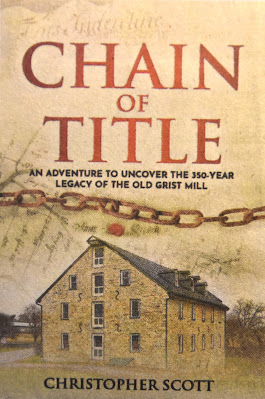Sunday, August 11, 2024
The Book Adds To Story Of Lancaster County's Early Settlers Story
It was an ordinary day. Reading about a retired engineer named Scott, who moved from New Jersey to a Lime Mill along the Pequea Creek near Willow Street, Pennsylvania. It was seven years ago and he moved to the grist mill that had been built in 1846 by George and Susanna Lefevre, but had been abandoned and was in need of substantial repairs. Scott was an engineer from New Jersey and now has a tale to tell about how he made the grist mill habitable. Seems that the people who owned the mill before he did, owned the land before the mill was built on it. Scott tells his story in a new book, "Chain of Title: An Adventure to Uncover the 350-Year Legacy of the Old Grist Mill." The self-described amateur historian describes his meticulous research concerning who owned the mill and when they owned it, in deep detail. This is a primer about how to conduct such a complex investigation as much as a description of the researcher's findings. In his mining of the mill's lore, Scott discovered several nuggets of new information. He found that Quakers, not Mennonites, originally owned the land on which his mill was built. And, he found the names of two new families to add to the Herrs, Kendigs and other "first settlers" of the Willow Street area. Scott concentrated on primary documents. He spent two and a half years searching through the archives of historical societies and libraries around the world. His greatest discovery was not so far from home -- in Chester county. Chester encompassed Lancaster County in 1703, when Amos Strettle purchased a 5,000 acre Penn grant from George Shoar. Scott realized that Penn, Shoar and Strettle were Quakers. So were the next three owners of the land before the property was subdivided and sold in 1731. None of these men lived on the land. So all of the early owners of the property on which Scott's mill was built were Quakers. The settlers of the land immediately to the north are primarily Mennonites. But many people think Mennonites owned all of the land, north and south. "I shudder to think how it will be received when the truth is revealed that the lands here were not owned by the celebrated Mennonite settler Hans Herr, but by a Quaker," Scott writes. Scott's dogged sears for original documentation also uncovered an old booklet at the Chester County Historic Society that named the settlers who'd been farming along the Pequea since 1710. The names include Herrs, Kendigs, Meylins and others found on many lists of early Swiss, German and French refugees. But the source Scott found, listed two more names of men who lived on the Strettle property to the south. They are Henry Carpenter and Henry Haines. The two men apparently arrived in Philadelphia before the Mennonites came here in 1710. Scott says Carpenter and Haines are not known to be Mennonites. Furthermore, he believes they were squatters who were forced to purchase their farms when the Quaker owner Thomas Hatton subdivided his property in 1731. Quite a story of Quakers and squatters that began as a "simple" search for a chain of title to Scott's old grist mill. And...so it goes. It was another extraordinary day in the life of an ordinary guy.

No comments:
Post a Comment